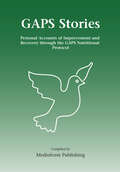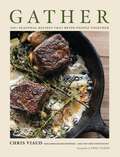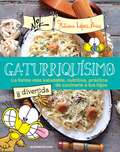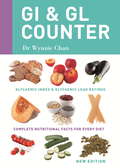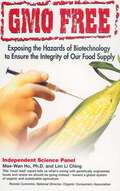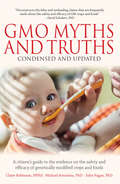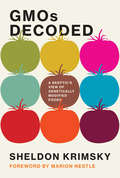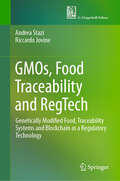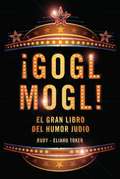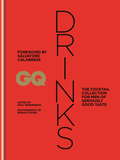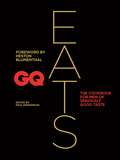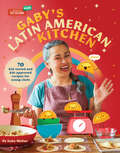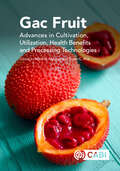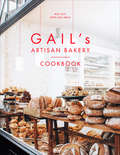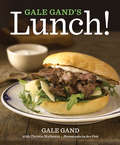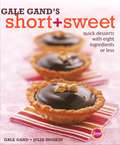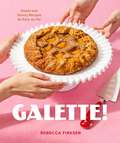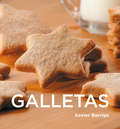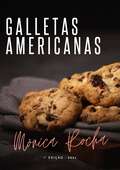- Table View
- List View
GAPS Stories: Personal Accounts of Improvement and Recovery Through the GAPS Nutritional Protocol
by Chelsea Green PublishingDr. Natasha Campbell-McBride created the term GAPS (Gut and Psychology Syndrome or Gut and Physiology Syndrome) in 2004 to describe the plethora of health problems that stem from an unhealthy gut. Since developing the GAPS nutritional protocol, Dr. McBride has received letters from GAPS sufferers all over the world: stories written by real people who have overcome their real health problems. Every one of these people has learned valuable lessons on their healing journey: lessons they are keen to pass to others who may be struggling through the same difficulties. These stories can be utilized as case studies for how to progress through personal healing and how to deal with problems that one may have to face along the way. There is nothing more valuable than real life experience! Those who have lived through something, fought the battle and won, know what is true and what is false, what works and what doesn&’t. Many of these stories are humbling–the kinds of horrific problems that people have had to deal with are hard to imagine for the majority of us–yet told with humor and grace!
GATHER: 100 Seasonal Recipes that Bring People Together
by Chris ViaudFrom James Beard nominee and Top Chef contestant Chef Chris Viaud comes GATHER, featuring recipes that not only bring friends and family together but keep them at the table. Whether you&’re hosting a cookbook club night in, or offering a housewarming gift to new neighbors, this mouth-watering cookbook will satisfy all cravings.To Chef Chris Viaud, food is a shared language that allows us to communicate with complete strangers, create lasting memories with friends and family, and get in touch with ourselves. It is the best way to nourish and expand a community. GATHER is a celebration of food&’s magical capacity to connect and transform. Featuring 100 recipes that focus on the innovative, accessible, and seasonal cuisine that earned Viaud a James Beard nomination and wowed the judges on Top Chef, this cookbook is centered around the incredible potential in gatherings of all sizes.Inside you&’ll find:100 seasonal appetizersBold and wholesome family-style entreesUnique, eye-catching cocktails perfect for entertainingElegant desserts for all cravingsStunning original photographyTips and techniques that promise to revolutionize your approach in the kitchen GATHER is perfect gift for:Mother&’s day or Father&’s day for the chefs in your lifeHost or hostess who enjoy entertainingHousewarming or new homeownersChristmas, birthdays, or other holidaysEasy to assemble and satisfying to serve, this repertoire is made for the heart of your home. Foster a deeper appreciation for every aspect of a meal, from those who cultivated the ingredients to the ones who sit beside us at the table. Feel good about what you put on your plate with GATHER.
GATURRIQUISIMO (EBOOK)
by J. Lopez MayLlegó el libro de cocina que faltaba! La combinación perfecta entre las recetas sanas y prácticas de Juliana López May y las travesuras de Gaturro suelto en la cocina. Un libro que divierte, enseña a cocinar con recetas que puede hacer toda la familia, y sobre todo enseña a comer mejor, derribando por el camino el mito de que sano no es igual que rico. Porque sano puede ser perfectamente# Gaturriquísimo!
GI & GL Counter
by Dr Wynnie ChanThe ultimate guide to the nutritional content, including GI (Glycaemic Index) and GL (Glycaemic Load) ratings, of over 1,900 favourite foods and drinks - essential information for anyone who follows a low-GI diet or has special dietary needs, such as diabetes. At-a-glance tables also show fat, calories, protein, fibre and carbohydrate content.
GMO Free
by Mae-Wan Ho Lim Li ChingThe genetic engineering of food crops is an ecological hazard and health crisis that affects us all. Its consequences are global and potentially irrevocable. Yet the decision to use genetically modified organisms is currently being made for you by the government and major multinational corporations. To combat this practice, more than 600 scientists from 72 countries have called for a moratorium on the environmental release of GMOs. GMO Free is the most comprehensive resource available on the science behind this worldwide debate.GMO Free takes a good look at the evidence scientists have compiled, and makes a powerful case for a worldwide ban on GMO crops, to make way for a shift to sustainable agriculture and organic farming. It&’s time to take the future of your food supply and environment into your own informed hands. GMO Free will give you the information you need to do so.
GMO Myths and Truths: A Citizen’s Guide to the Evidence on the Safety and Efficacy of Genetically Modified Crops and Foods, 3rd Edition
by Claire Robinson John Fagan Michael AntoniouIt is often claimed that the case against genetically modified (GM) crops and foods is based on emotion, not science, and that to oppose GM crop and food technology is to be anti-science. It is also claimed that GM crops offer higher yields and better nutrition, that they are safe for health and the environment, that they reduce agrochemical use, and that they are needed to feed the world's growing population. This book, co-authored by two genetic engineers and a writer/researcher, exposes these claims as false, using scientific and other documented evidence. GMO Myths and Truths summarizes the facts on the safety and efficacy of genetically modified (GM) crops and foods in terms that are accessible to the non-scientist but still relevant to scientists, policymakers and educators. The evidence presented points to many hazards, risks, and limitations of genetic engineering technology. These include harms found in animal feeding and ecological studies, which in turn indicate risks to health and the environment posed by GM crops and foods. The layout of the book enables those readers with limited time to read the chapter summaries, while providing more detail and full references for those who require them. At 164 pages of paperback size, this new condensed version is shorter and more accessible than the authors' 330-page report by the same name, which has been downloaded over half a million times. The book shows that conventional breeding continues to outstrip GM in developing crops that deliver high yields, better nutrition, and tolerance to extreme weather conditions and poor soils. In agreement with over 400 international experts who co-authored a UN and World Bank-sponsored report on the future of farming, the authors conclude that modern agroecology, rather than GM, is the best path for feeding the world's current and future populations in a safe and sustainable way.
GMOs Decoded: A Skeptic's View of Genetically Modified Foods (Food, Health, and the Environment)
by Sheldon KrimskyThe debate over genetically modified organisms: health and safety concerns, environmental impact, and scientific opinions.Since they were introduced to the market in the late 1990s, GMOs (genetically modified organisms, including genetically modified crops), have been subject to a barrage of criticism. Agriculture has welcomed this new technology, but public opposition has been loud and scientific opinion mixed. In GMOs Decoded, Sheldon Krimsky examines the controversies over GMOs—health and safety concerns, environmental issues, the implications for world hunger, and the scientific consensus (or lack of one). He explores the viewpoints of a range of GMO skeptics, from public advocacy groups and nongovernmental organizations to scientists with differing views on risk and environmental impact.Krimsky explains the differences between traditional plant breeding and “molecular breeding” through genetic engineering (GE); describes early GMO products, including the infamous Flavr Savr tomato; and discusses herbicide-, disease-, and insect-resistant GE plants. He considers the different American and European approaches to risk assessment, dueling scientific interpretations of plant genetics, and the controversy over labeling GMO products. He analyzes a key 2016 report from the National Academies of Sciences on GMO health effects and considers the controversy over biofortified rice (Golden Rice)—which some saw as a humanitarian project and others as an exercise in public relations. Do GMO crops hold promise or peril? By offering an accessible review of the risks and benefits of GMO crops, and a guide to the controversies over them, Krimsky helps readers judge for themselves.
GMOs, Food Traceability and RegTech: Genetically Modified Food, Traceability Systems and Blockchain as a Regulatory Technology
by Andrea Stazi Riccardo JovineThe book deals with the regulation of GMOs within the context of multiple principles and interests, including food security, sustainable development, and biodiversity. The recognition of intellectual property rights, particularly with respect to geographical indications and patentability is also discussed. From a comparative perspective, the importance of traceability in the food industry, driven by major world powers' consumer and market protection policies, is highlighted. Finally the use of emerging technologies, such as blockchain, as a form of "regulatory technology" for more effective and sustainable management of traceability systems within the food supply chain, is explored as a workable and forward looking solution.
GOGL MOGL. EL GRAN LIBRO DEL HUMOR (EBOO
by Toker Rudy-EliahuEl Gogl Mogl es un exquisito postre muy popular entre los judíos de Europa Oriental. Es una delicia casera, a base de yemas de huevo crudo batidas con azúcar o miel, más un chorrito de licor. Ingredientes variados que mezclados forman un gusto exquisito y original, como el humor judío. Este libro tiene algo de mucho sabor. Sus páginas recorren la divertida gama de matices acuñada por el humor judío desde sus primeros días, cuando Eva le contaba las costillas a Adán cada vez que volvía de darse una vuelta por el Paraíso, hasta hoy. Una vez que tengas este libro en tus manos, los autores te recomiendan que apagues el celular y te ubiques cómodamente en un sillón para leerlo, después de dejar en el contestador los siguientes mensajes: "Si es mi mamá, estoy bien, cuando pueda te llamo; si es mi analista, estoy muy mal y necesito su ayuda urgente; si es el doctor: me duele acá venga a verme, pero avise cuándo viene, así la conoce a mi hija la soltera; si es un acreedor, está equivocado de número". Ahora sí ya estás listo para comenzar a deleitarte con nuestro libro. Que lo disfrutes!
GQ Drinks (GQ #4)
by Paul HendersonThe anticipated follow-up to GQ Eats, this ultimate drinks book features creations from bar legends such as Salvatore Calabrese as well as innovative mixes from new talent from the UK's best bars. As well as over 120 recipes for classic and cutting-edge cocktails, you will also find inside tips such as which are the best brands to use for the perfect G+T. A special section on hardware covers the glasses to use and the shakers that are worth spending money on.
GQ Drinks: (Special iPad Edition) (Gq Ser.)
by Mitchell BeazleyThe anticipated follow-up to GQ Eats, this ultimate drinks book features creations from bar legends such as Salvatore Calabrese as well as innovative mixes from new talent from the UK's best bars. As well as over 120 recipes for classic and cutting-edge cocktails, you will also find inside tips such as which are the best brands to use for the perfect G+T. A special section on hardware covers the glasses to use and the shakers that are worth spending money on.
GQ Eats: The Cookbook For Men Of Seriously Good Taste (Gq Ser.)
by Paul Henderson'If food is the new Rock 'N' Roll, this recipe book is Sgt. Pepper's.' - Heston BlumenthalFrom the magazine synonymous with style comes the ultimate cookbook for men with discerning taste.Featuring recipes from the UK's best restaurants, plus tips and techniques from the country's top chefs, GQ Eats is an indispensable guide for enthusiastic home cooks, sophisticated diners and good-food fanatics. This is the best of British food for men who want to cook and for women who want to know what to feed them.With contributions from leading chefs and food writers including: Jason Atherton; Raymond Blanc; Heston Blumenthal; Fergus Henderson; Giorgio Locatelli; Yotam Ottolenghi; Oliver Peyton; Gordon Ramsay; Mark Hix; Michel Roux Jnr; Marcus Wareing and Bryn Williams.The recipes provide inspiration for any occasion, from Brilliant Breakfasts to food for a Boys' Night In (Daniel Boulud's Coq au Vin), Michelin-star Meals such as Giorgio Locatelli's Tomato and Chilli Pasta with Prawns and Gordon Ramsay's Honey and Cider Roast Leg of Lamb, and Rock 'n' Roll Roasts - from Pitt Cue's pulled pork to Mark Hix's Roast Chicken. Remember to save room for alfresco feasts, delectable desserts and killer cocktails.Accompanied by images from brilliant photographers Romas Ford and Tom Schierlitz, GQ has created a cutting-edge compendium of recipes to cook again and again.Contents Includes:BRILLIANT BREAKFASTS Start the day the GQ way with American pancakes, eggs Benedict, or the best bacon sandwich.BEST OF BRITISH Including Mark Hix' bubble and squeak, Fergus Henderson's veal and pea soup, Simon Wadham's potted shrimps and Billy Reid's Lancashire hotpot.BOYS' NIGHT IN Man-sized meals best served with beer, wine, or both, including Daniel Boulud's coq au vin, Karam Sethi's seekh kebabs and William Leigh's fried chicken nuggets.HEALTH-CONSCIOUS CLASSICS Make-overs of food favourites for men who want a healthy option, including chicken korma, a healthy burger and Stuart Gillies' shepherd's pie.MICHELIN-STAR MEALS Michelin-star chefs demonstrate their talents, including John Campbell's wild mushroom risotto, Giorgio Locatelli's tomato and chilli pasta with prawns, Daniel Boulud's steak tartare and Michel Roux Jnr's lobster mango salad.ALFRESCO FEASTS The great outdoors gets even greater thanks to GQ. Includes recipes for sandwiches, burgers, kebabs, salads and wraps, plus advice on how to become the king of the barbecue.PUB FOOD FAVOURITES Whether it is Claude Bosi's sausage roll, Jason Atherton's salt and pepper squid, Heston Blumenthal's Scotch egg or Ramond Blanc's French onion soup, these recipes will have everyone coming back for more.ROCK 'N' ROLL ROASTS You can't beat our meat. Chicken, beef, pork, lamb, even a guide to smoking your own Pitt Cue pulled pork.JUST DESSERTS Because real men do eat mousse, syllabub and sorbet... sometimes.COCKTAIL HOUR Creations from bar legends.
GQ Eats: The cookbook for men of seriously good taste (GQ #1)
by CONDE NAST INDEPENDENT MAGAZIN'If food is the new Rock 'N' Roll, this recipe book is Sgt. Pepper's.' - Heston Blumenthal.From the magazine synonymous with style comes the ultimate cookbook for men with discerning taste.Featuring recipes from the UK's best restaurants, plus tips and techniques from the country's top chefs, GQ Eats is an indispensable guide for enthusiastic home cooks, sophisticated diners and good-food fanatics. This is the best of British food for men who want to cook and for women who want to know what to feed them. With contributions from leading chefs and food writers including: Jason Atherton; Raymond Blanc; Heston Blumenthal; Fergus Henderson; Giorgio Locatelli; Yotam Ottolenghi; Oliver Peyton; Gordon Ramsay; Mark Hix; Michel Roux Jnr; Marcus Wareing and Bryn Williams.The recipes provide inspiration for any occasion, from Brilliant Breakfasts to food for a Boys' Night In (Daniel Boulud's Coq au Vin), Michelin-star Meals such as Giorgio Locatelli's Tomato and Chilli Pasta with Prawns and Gordon Ramsay's Honey and Cider Roast Leg of Lamb, and Rock 'n' Roll Roasts - from Pitt Cue's pulled pork to Mark Hix's Roast Chicken. Remember to save room for alfresco feasts, delectable desserts and killer cocktails.Accompanied by images from brilliant photographers Romas Ford and Tom Schierlitz, GQ has created a cutting-edge compendium of recipes to cook again and again.Contents Includes:BRILLIANT BREAKFASTSStart the day the GQ way with American pancakes, eggs Benedict, or the best bacon sandwich.BEST OF BRITISHIncluding Mark Hix' bubble and squeak, Fergus Henderson's veal and pea soup, Simon Wadham's potted shrimps and Billy Reid's Lancashire hotpot.BOYS' NIGHT INMan-sized meals best served with beer, wine, or both, including Daniel Boulud's coq au vin, Karam Sethi's seekh kebabs and William Leigh's fried chicken nuggets.HEALTH-CONSCIOUS CLASSICSMake-overs of food favourites for men who want a healthy option, including chicken korma, a healthy burger and Stuart Gillies' shepherd's pie.MICHELIN-STAR MEALSMichelin-star chefs demonstrate their talents, including John Campbell's wild mushroom risotto, Giorgio Locatelli's tomato and chilli pasta with prawns, Daniel Boulud's steak tartare and Michel Roux Jnr's lobster mango salad.ALFRESCO FEASTSThe great outdoors gets even greater thanks to GQ. Includes recipes for sandwiches, burgers, kebabs, salads and wraps, plus advice on how to become the king of the barbecue.PUB FOOD FAVOURITESWhether it is Claude Bosi's sausage roll, Jason Atherton's salt and pepper squid, Heston Blumenthal's Scotch egg or Ramond Blanc's French onion soup, theserecipes will have everyone coming back for more.ROCK 'N' ROLL ROASTSYou can't beat our meat. Chicken, beef, pork, lamb, even a guide to smokingyour own Pitt Cue pulled pork.JUST DESSERTSBecause real men do eat mousse, syllabub and sorbet... sometimes.COCKTAIL HOURCreations from bar legends.
GREAT GRILLING
by Lw Press[From the Back cover[ Fire up the flavor! Let the tasty recipes in Great Grilling make you the hit of the summer barbecue!
Gabriella's Kitchen: Recipes and Tales from a Greek Island
by Gabriella CristianiWhen Gabriella first saw the Greek island of Corfu, "it was simply paradise"—except that there were no good restaurants. So she and her sociable Greek husband rented a charming old Venetian villa "effectively hidden from the road, and from clients, by an ancient wall submerged in wisteria" and opened their own. The garden was so full of magnolia, olive, and fruit trees that they only had room for a few tables. Here, Gabriella began a 30-year self-apprenticeship in the art of fine cooking, developing her own special recipes and catering to the rich and famous who increasingly found their way to her door (Julian Huxley, Paul McCartney, and Albert Finney, to name a few). For relaxation, and between customers, Gabriella created patchwork images of her paradisiacal home. In this bright, practical, and unusual cookbook, Gabriella shares her original recipes: delectable "starters"—often meals in themselves—breads and pizzas, simple and delicious fish and chicken dishes (including one that earned her a kiss from George Peppard), and creative, easy-to-prepare desserts. Sprinkled throughout the book are engaging stories of people and events that coloured and enriched her life. Gabriella closed her restaurant in 1985 after the death of her husband, and made several prolonged visits to Canada before finally making Halifax, Nova Scotia, her home.
Gaby's Latin American Kitchen: 70 Kid-Tested and Kid-Approved Recipes for Young Chefs
by Gaby MelianCelebrity Chef Gaby Melian brings you into her kitchen to teach the best recipes she&’s learned from all over Latin America. From desayuno (breakfast) to cena (dinner), merienda (snacks) to postre (dessert), your young chef will be a pro in no time. ¡En sus marcas, listos… fuera! Ready, set, cook!Have you ever tried empanadas? Made cheesy arepas for your family? Or shared homemade, sprinkle-covered chocolate brigadeiros with your friends? Travel the world of Latin America with 70 recipes developed and written by Gaby Melian—all kid-tested and kid-approved by America&’s Test Kitchen Kids' panel of over 15,000 at-home kid recipe testers. A Spanish glossary, fun personal stories, and a peek into Gaby's own kitchen make this book a delicious win for all young chefs and their families! Kids can cook from breakfast to dessert with recipes such as:Arepas con Queso: These Colombian-style round corn cakes are cooked on the stovetop, then stuffed with gouda cheese that melts and gets gooey after a few minutes in the oven.Ensalada de Frutas: This fruit salad is the solution to hot summer days. Add orange juice, water, and ice to the fruit, stir gently to combine, and serve with plenty of juice spooned on top of each serving—the juicier the better!Panqueques con Dulce de Leche: A distant cousin to French crepes, these panqueques are just as delicious, and a bit more forgiving—make them as thick or as thin as you like, with a lot of browning. After cooking, they're filled with luscious, sweet dulce de leche. Empanadas de Pollo: Empanadas are a delicious labor of love. To make them simpler to prepare, this version uses store-bought hojaldradas-style empanada dough rounds and rotisserie chicken.
Gac Fruit: Advances in Cultivation, Utilization, Health Benefits and Processing Technologies
by Van Anh Le Servan Ersan Chuyen V. Hoang Tien Huynh Cang H. Mai Judith Müller-Maatsch Dao T. Nguyen Sophie E. Parks Huan Phan-Tai Huu Tai Pham Ngoc T.M Ta Xuan T. TranGac fruit, Momordica cochinchinensis Spreng, is rich in nutrients such as carotenoids (particularly ß-carotene and lycopene), fatty acids, vitamin E, polyphenol compounds and flavonoids. This book provides the latest research on this fruit, from cultivation through to novel processing technologies for health products. It addresses several techniques for propagation and cultivation in order to increase the production and quality of Gac fruit, including traditionally used parts of the fruit (aril) and those whose value has not yet been maximized (peel, pulp and seed). This plant has the potential to be a high value crop, particularly as parts of the fruit can be processed into nutrient supplements and natural colorants. Currently only the aril is commercially harvested, and this presents opportunities for upcycling the rest of the fruit. As such, this book contains special emphasis on: · Improving yield and fruit quality. · Extraction methods of Gac oil rich in ß-carotene and lycopene from the aril and peel. · Encapsulation of Gac oil and applications in various food products. · Nutritional values and bioactive compounds of Gac pulp and peel. · Processing and utilization of Gac seeds. · The market for Gac target products. Practical applied technologies such as microwave drying, heat pump drying, freeze drying, ultrasound assisted extraction, supercritical CO2 extraction, encapsulation techniques are all presented. This is an essential reference text for academics, researchers and graduate students in Gac fruit cultivation, food processing, science and nutrition. Product developers in health food and health supplements will also find it valuable.
Gail's Artisan Bakery Cookbook: the stunningly beautiful cookbook from the ever-popular neighbourhood bakery
by Roy Levy Gail MejiaWith mouth-watering photography and over 100 delicious recipes, the team behind GAIL's will take you through the basics of breadmaking and then take you on to preparing a whole cornucopia of sweet and savoury tasty treats and flavourful meals.'An amazingly helpful fail proof book' -- ***** Reader review'If you love baking, you need this in your life!' -- ***** Reader review'Packed with delicious recipes to make over and over again' -- ***** Reader review'Worth every penny - joyful!' -- ***** Reader review***************************************************************************************"Good bread begins with just four honest ingredients: flour, water, salt and yeast. Nothing could be simpler and yet nothing is more gratifying." -- GAIL'sSince opening the first GAIL's in 2005, the team behind the UK's most inviting artisan bakery has been on a mission to bring high-quality, handmade bread and delicious vibrant food to local communities. In this, their first, stunning cookbook, GAIL's take us through the day with inventive, fresh recipes.Starting with the essential how-tos of mixing, kneading and shaping loaves before going on to offer over 100 varied savoury and sweet recipes, GAIL's will encourage you to try your hand at a basic foolproof bloomer, bake a satisfying sourdough, create morning muffins and pastries, bold salads, flavoursome pies, appetizing tarts and sandwiches, easy afternoon biscuits and cakes, and finally cook delicious savoury meals and desserts for supper.Simply divided into Baker's Essentials, Bread, Breakfast, Lunch, Tea and Supper, the GAIL's Cookbook includes:White poppy seed bloomerFrench dark sourdoughWholemeal loafFocacciaBrioche plum and ginger puddingBuckwheat pancakes with caramelised apples and salted butter honeyPizza Bianca with violet artichokes and burrataTruffle, raclette and roast shallot toastieTeatime sandwichesSavoury scones & fruit sconesRed quinoa and smokey aubergine yoghurt saladBaked sardines with sourdough crumbs and heritage tomato saladFregola and chicken saladBaked bread and chicken soupTuna Nicoise on toastSourdough lasagnaRoot vegetable and Fontina bakeLeek and goat's cheese picnic loafBrown sourdough ice cream with raspberry
Gale Gand's Brunch!: 100 Fantastic Recipes for the Weekend's Best Meal: A Cookbook
by Christie Matheson Gale GandEvery weekend is worth celebrating when you can relax over a good brunch. Food Network host, cookbook author, celebrated chef, and mother of three, Gale Gand has long made brunch a part of her life because it's the easiest way to gather around the table with family and friends. Now, in Gale Gand's Brunch! she shares 100 recipes for scrumptious brunch fare, all destined to become household favorites. Traditional breakfast treats become inspired dishes when Gale shares how to effortlessly enliven the basics, like Iced Coffee with Cinnamon-Coffee Ice Cubes, Baked Eggs in Ham Cups, and Almond Ciabatta French Toast. In five mini-classes, she teaches how to master easy but impressive classic egg dishes-omelets, quiches, strata, frittata, and crêpes-with numerous variations on each. Finally, no cookbook by Gale would be complete without recipes for the wonderful baked goods she's famous for, such as Ginger Scones with Peaches and Cream, Moist Orange-Date Muffins, Glazed Crullers, and Quick Pear Streusel Coffee Cake. Special occasion or not, brunch is a cinch with Gale's irresistible recipes. Start off the day with zesty Breakfast Burritos for the kids, or wow visiting in-laws with Poached Salmon with Cucumber Yogurt. Anyone will find Gale's salads, soups, and sides delicious and simple, and with 60 color photographs, you'll be enticed to try a new recipe every weekend. Wake up to a great weekend with Gale Gand's Brunch!From the Hardcover edition.
Gale Gand's Lunch!
by Christie Matheson Gale GandRevive the midday meal! “Every dish hews to her philosophy of delicious, nourishing, and seasonally sourced foodstuffs, geared to kids and adults alike.” —Booklist (starred review)It’s time for a lunch revolution. Lunchtime doesn’t need to be about hurrying through an assortment of processed products. Make it a fabulous opportunity to enjoy delicious ingredients and flavor-packed dishes and to slow down while you eat (even if just for a few moments). Acclaimed chef Gale Gand shows you how to make it happen—simply and easily, and for a fraction of the price of prepared salads and sandwiches. Gand offers 150 recipes—including plenty of kid-friendly fare (tested and approved by Gand’s own children)—along with tons of tips for packing foods to go or turning lunch into a celebration with friends and family. As Gand says, when it comes to entertaining, “lunch is the new dinner.” Chapters on soups, pastas, salads, grains, fruits, and more, as well as desserts, drinks, dips, and snacks, provide countless combinations for memorable meals at home or on the go.“This book delivers, in the most wonderful way, the central meal of the day. We all aspire to send our children and ourselves off to school or work with the most amazing lunches. And the task just got a lot easier and more delicious with Lunch!” —Cat Cora, lifestyle entrepreneur and Iron Chef“Here’s to Gale’s Honey-Mustard Pretzel Rolls, Dilled Green Bean Pickles, and Fresh Ginger Ale, finished off with Apple Pie Pops or Devil Dogs. Or both! That middle child never looked so good.” —Sara Moulton, host of the public television show Sara’s Weeknight Meals
Gale Gand's Short and Sweet: Quick Desserts with Eight Ingredients or Less: A Cookbook
by Julia Moskin Gale GandFrom Gale Gand, award-winning executive pastry chef and host of Food Network's Sweet Dreams, more than 75 tempting desserts that are long on flavor . . . even when you're short on time.From the Hardcover edition.
Galette!: Sweet and Savory Recipes as Easy as Pie
by Rebecca FirkserThe genius galette—unfussy, easy to make, and fully customizable—is presented in 50 mouthwatering recipes in a book that every baker needs in their library. The galette is a rustic, freeform tart. It requires a few simple ingredients, and minimal equipment, meaning that with some pantry basics, a home cook can put one together for no more than the cost of fresh (or frozen!) produce. A galette can be sweet or savory, filled with any imaginable combination of fruits or veggies, meats, cheeses, and spices. Great for a party, they can be prepared in advance, but they also come together quickly when you&’re in a pinch—and galettes can be made year-round with whatever produce is available. Galette! celebrates this humble pastry, offering easy-to-follow and customizable recipes. With one basic crust recipe, endless galette possibilities are within reach. Incorporate summer&’s bounty into a galette with peaches and granola or use pantry items in a galette with marinated artichokes and tomatoes. Brown-Buttered Apples and Honey, rolled out and baked like a slab pie, is the perfect dessert for a crowd, while individual Lemony Spinach and Rice galettes work well for a family dinner. No matter the filling, galettes are the ideal, foolproof bake for home cooks.
Galletas
by Xavier BarrigaPor fin llega el turno de las galletas, Xavier Barriga nos presenta unas sencillas recetas explicadas paso a paso. Gracias a los consejos del autor, conseguiremos que nuestro horno produzca una multitud de apetitosas galletas que harán las delicias de nuestros familiares, amigos...En el libro de recetas encontrarás:- Los utensilios más necesarios para elaborar galletas y que debemos tener en cuenta en las diferentes fases del proceso de preparación.- Los pasos básicos, donde veremos el procedimiento detallado para elaborar los dos tipos de masa más habituales, a partir de los cuales se preparan buena parte de las galletas de este libro. Se trata de la masa para galletas de manga y la masa para galletas de corte.- Y recetas para todos los gustos:Recetas de galletas para una merienda perfecta (Rosquillas crujientes de almendra tostada, botones, herraduras de mantequilla con chocolate...)De diferentes formas y colores (Galletas de pasas y ron, galletas crujientes de dulce de leche, sables de coco...)Las muy fashion (Teja de sésamo negro tostado, cigarrillo ruso relleno de praliné, galletas rellenas de crema y limón, galletas blandas con crema pastelera, sablés de mermelada de frambuesa...)Las de toda la vida (cocos gratinados, carquiñolis...)Galletas saladas y diferentes (Galletas de zanahoria y queso fresco, milhojas de centeno con guacamole...)Galletas con mucha fibra (Cookies de espelta integral y copos de avena, crackers integrales extrafinos...)Las que no vas a resistir (Florentinas de naranja y piñones tostados, pequeños bocados de cabello de ángel, galletas crujientes de limón y amapola, las de coco pasión, galletas de chocolate y caramelo, tejas de almendra con pannacotta...)Y otras elaboraciones, consejos y trucos.
Galletas
by Xavier BarrigaDeliciosas recetas de Xavier Barriga para realizar tus propias galletas en casa. Por fin llega el turno de las galletas, Xavier Barriga nos presenta unas sencillas recetas explicadas paso a paso. Gracias a los consejos del autor, conseguiremos que nuestro horno produzca una multitud de apetitosas galletas que harán las delicias de nuestros familiares y amigos. En el libro de recetas encontrarás: - Los utensilios más necesarios para elaborar galletas y que debemos tener en cuenta en las diferentes fases del proceso de preparación. - Los pasos básicos, donde veremos el procedimiento detallado para elaborar los dos tipos de masa más habituales, a partir de los cuales se preparan buena parte de las galletas de este libro. Se trata de la masa para galletas de manga y la masa para galletas de corte. - Y, además, recetas para todos los gustos:** Recetas de galletas para una merienda perfecta (Rosquillas crujientes de almendra tostada, botones, herraduras de mantequilla con chocolate...) ** De diferentes formas y colores (Galletas de pasas y ron, galletas crujientes de dulce de leche, sables de coco...) ** Las muy fashion (Teja de sésamo negro tostado, cigarrillo ruso relleno de praliné, galletas rellenas de crema y limón, galletas blandas con crema pastelera, sablés de mermelada de frambuesa...) ** Las de toda la vida (cocos gratinados, carquiñoles...) ** Galletas saladas y diferentes (Galletas de zanahoria y queso fresco, milhojas de centeno con guacamole...) ** Galletas con mucha fibra (Cookies de espelta integral y copos de avena, crackers integrales extrafinos...) ** Las que no vas a resistir (Florentinas de naranja y piñones tostados, pequeños bocados de cabello de ángel, galletas crujientes de limón y amapola, las de coco pasión, galletas de chocolate y caramelo, tejas de almendra con pannacotta...) Y otras elaboraciones, consejos y trucos.
Galletas americanas
by Mônica Rocha¡Todo lo que necesita saber para comenzar a elaborar y vender galletas americanas! Usted tendrá el conocimiento sobre técnicas y lo que es necesario para realizar o comenzar a trabajas con galletas. Variedad de recetas. Aprenderá cuál es el mejor momento para invertir en más materiales. Tendrá una planilla para el cálculo del precio de la receta. Ingreso extra con horario flexible. ¡Más de 100 páginas!
